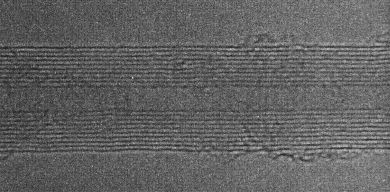 TEM image of a multi-walled carbon nanotube. Each concentric layer can easily be seen.
TEM image of a multi-walled carbon nanotube. Each concentric layer can easily be seen.
 Here a single wall nanotube is seen by TEM.
Here a single wall nanotube is seen by TEM.Presently we are working on characterizing the properties of nanotubes. Along with sophisticated transport measurement methods, our group has developed very sensitive mechanical measurement techniques such as the Vibrating Reed Technique which has been previously used to measure properties of novel superconductors in this lab. Since carbon nanotubes are predicted to have a Young's Modulus thirty times that of steel, we are attempting to use variations of the vibrating reed technique to measure the mechanical properties of these nanostructures. This type of measurement is done inside the imaging environment of the TEM. Although the high aspect ratio of nanotubes makes them ideal specimens for a vibrating resonance type of measurement, their nanoscale diameters make them challenging samples to work with. Along with these projects, we have used the TEM to perform some careful studies of the structure of carbon nanotubes and have found, in fact, tubes which have completely collapsed and flattened to ribbon-like structures. By rotating in situ in the TEM we verified this flattened state of the tube, and theoretical calculations confirmed the collapsed state to be an energetically stable configuration.